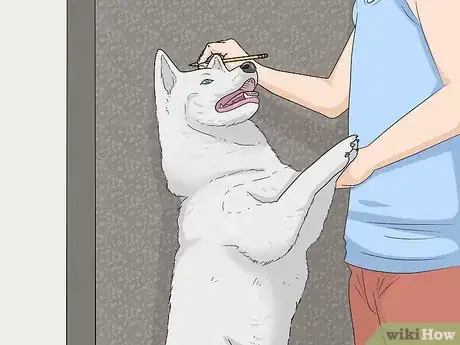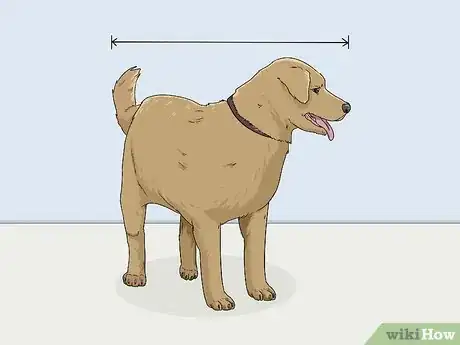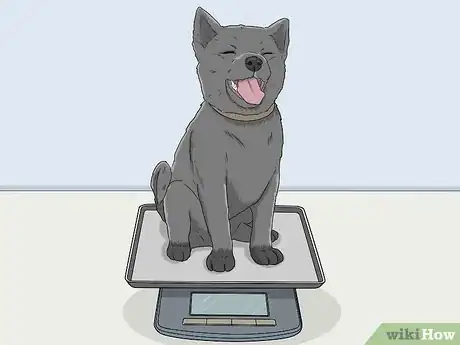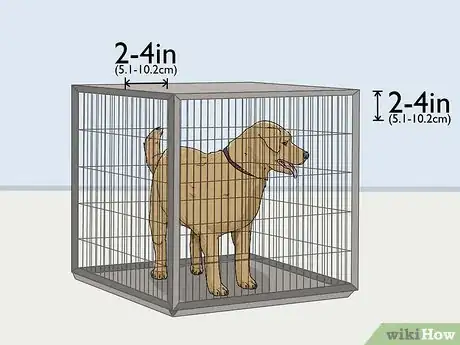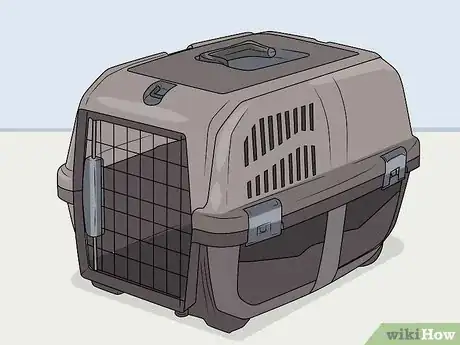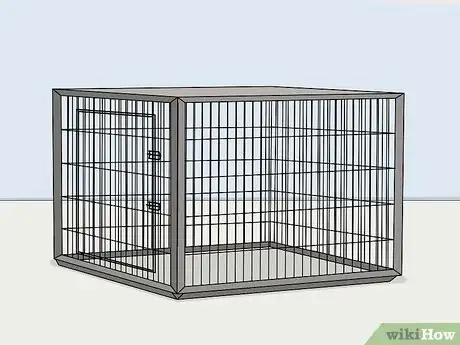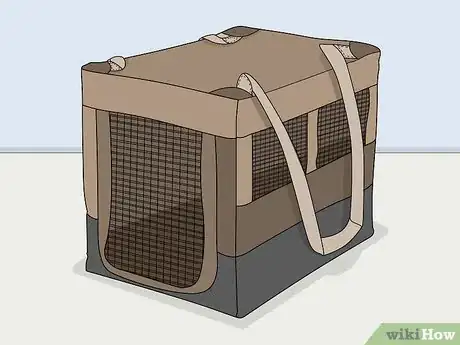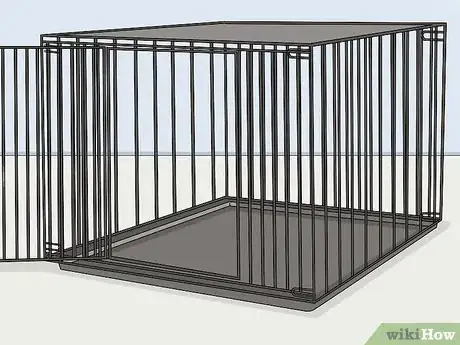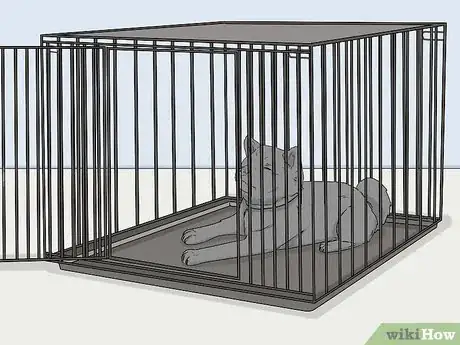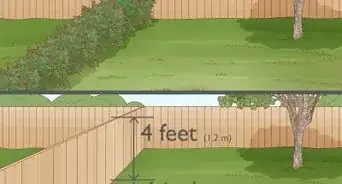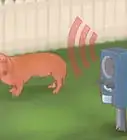This article was co-authored by Rendy Schuchat. Rendy Schuchat is a Certified Professional Dog Trainer and the Owner of the largest dog training facility, Anything Is Pawzible, based in Chicago, Illinois. With over 20 years of experience, Rendy specializes in positive dog training and behavior modification to help people build and strengthen their relationships with their dogs. She holds a BA in Psychology and Communications from the University of Iowa, an MA in Psychology from Roosevelt University, and a Certification in Dog Obedience Instruction from Animal Behavior Training and Associates. Rendy was voted one of the Best/Favorite Dog Trainers in Chicago by Chicagoland Tails Reader’s Choice Awards multiple times and was voted Chicago Magazine’s “Best Dog Whisperer” in 2015.
This article has been viewed 12,363 times.
Crates can be a great tool for house training puppies, giving your dog a safe space, or even help with separation anxiety. Your dog's crate should be a home within a home, not a prison, and finding the right size is an important factor in making it a comfortable space. To find the perfect crate for your pup, you just need their height, length, and weight. If you have a quickly growing puppy, look for an adjustable crate so that you don't need to buy a new one every few months.
Steps
Taking Your Dog's Measurements
-
1Mark your dog's measurements on a wall. You can more clearly see exactly how long and tall your dog is by having them stand against a wall. Mark the wall with something temporary like chalk or pencil. Then, measure the marks with a measuring tape.[1]
- Bribe your dog to stand still using a treat, if you can.
-
2Use a measuring tape to find your dog's length from nose to tail. To get the most accurate measurement, have your dog stand on all 4 paws. Measure from the tip of the nose to the base of the tail.[2]
- If you include the entire length of your dog's tail, the crate will be too big.
- If your dog has a very thick, long tail, include some extra length if you want. When your dog wags, the tail will hit the crate, so a little extra length will help.
Advertisement -
3Find out how tall your dog is sitting down. Measure from the floor to the highest point of your dog's head. If your dog has stiff ears that stand up, include them in your measurement.[3]
- Use a soft measuring tape to more easily find your dog's height while sitting.
-
4Weigh your dog. If you will ever need to carry your dog in the crate, make sure that your dog is under the maximum weight listed for the crate. Otherwise, you might damage or even break the crate if you carry your dog inside.[4]
- Alternatively, you can opt to have separate crates for home and travel.
Finding the Right Crate
-
1Add 2 to 4 inches (5.1 to 10.2 cm) to your dog's length and height. The perfect crate will give your dog enough room to stand up, turn around, sit down, and lie on their side. To make sure the crate is big enough, add a few inches to both the height and the length:[5]
- For small dog breeds, add 2 inches (5.1 cm) to the height and length measurements.
- For large dog breeds, add 4 inches (10 cm) to the height and length.
Warning: Take your dog's collar or harness off before putting them in a crate. If anything around the neck gets caught on the crate, your dog could choke. Try a breakaway-style collar if you want to leave an ID tag on.
-
2Go for a plastic crate if your dog is easily distracted. Plastic crates have less visibility than wire or metal crates. This can give some dogs a sense of security, especially when traveling. Plastic crates are also easy to clean and provide some insulation in cold climates.[6]
- It's best to avoid plastic crates if your dog gets stressed when they can't see their surroundings, or if you live in a very hot climate.
- Plastic crates are also better for small dogs than metal crates.
- If you have a larger dog, you can make it feel more secure by draping a heavy blanket over 3 sides of the crate.
-
3Opt for a metal crate for puppies and dogs that like to see their surroundings. Metal crates often come with a panel that lets you adjust the size of the inside. They are also easy to clean and affordable. You may need to find a waterproof liner to help the crate contain any accidents.[7]
- Strong, excited puppies can bend cheap wire crates with their teeth. Look for a reinforced steel crate if you are worried about your puppy escaping.
- Line the crate with a cozy blanket or bed to make it more comfortable.
-
4Use a soft-sided crate for travel. Soft-sided crates are lightweight and easy to transport. They are also easy to fold down and store. A soft-sided crate is best for a small, well-trained dog.[8]
- Soft-sided crates are not very durable and can be difficult to keep clean. They're best to use for travel only.
- This type of crate is also only suitable for a dog that won’t chew on the fabric.
-
5Buy a resizable crate to save money while your puppy is growing. A resizable crate can "grow" with your puppy as they get older. These crates come with a divider panel that you can use to make the main area of the crate smaller.[9]
- Make sure that the largest size of the crate will be big enough when your dog is fully grown.
- This is most useful for large breeds that grow quickly. Some breeds need an bigger size every 3 months.
-
6Use a crate on the smaller side to house train your puppy. Your puppy needs to be able to sit, lie, and turn comfortably in the crate. However, don't get a crate so large that your puppy can soil one side of it and lie on the other side. If you are between two sizes, go for the smaller one.[10]
- A too-large puppy crate can derail house training and make it more difficult for you to teach your dog where to potty.
-
7Adjust if your dog doesn't have enough space. Your dog's crate should be big enough that they can sit up without lowering their head. They should also be able to lay down and stretch out completely.[11] If you notice that your dog has outgrown its crate, it's time to size up.
- If you have an adjustable crate, simply size up. If not, measure your dog's length and height and buy a larger crate according to the new measurements.[12]
Expert Q&A
Did you know you can get expert answers for this article?
Unlock expert answers by supporting wikiHow
-
QuestionWhat size crate does my dog need?
 Rendy SchuchatRendy Schuchat is a Certified Professional Dog Trainer and the Owner of the largest dog training facility, Anything Is Pawzible, based in Chicago, Illinois. With over 20 years of experience, Rendy specializes in positive dog training and behavior modification to help people build and strengthen their relationships with their dogs. She holds a BA in Psychology and Communications from the University of Iowa, an MA in Psychology from Roosevelt University, and a Certification in Dog Obedience Instruction from Animal Behavior Training and Associates. Rendy was voted one of the Best/Favorite Dog Trainers in Chicago by Chicagoland Tails Reader’s Choice Awards multiple times and was voted Chicago Magazine’s “Best Dog Whisperer” in 2015.
Rendy SchuchatRendy Schuchat is a Certified Professional Dog Trainer and the Owner of the largest dog training facility, Anything Is Pawzible, based in Chicago, Illinois. With over 20 years of experience, Rendy specializes in positive dog training and behavior modification to help people build and strengthen their relationships with their dogs. She holds a BA in Psychology and Communications from the University of Iowa, an MA in Psychology from Roosevelt University, and a Certification in Dog Obedience Instruction from Animal Behavior Training and Associates. Rendy was voted one of the Best/Favorite Dog Trainers in Chicago by Chicagoland Tails Reader’s Choice Awards multiple times and was voted Chicago Magazine’s “Best Dog Whisperer” in 2015.
Certified Professional Dog Trainer
References
- ↑ https://animalso.com/what-size-dog-crate/
- ↑ https://animalso.com/what-size-dog-crate/
- ↑ https://animalso.com/what-size-dog-crate/
- ↑ https://www.preventivevet.com/dogs/how-to-measure-and-choose-a-dog-crate
- ↑ https://animalso.com/what-size-dog-crate/
- ↑ https://animalso.com/what-size-dog-crate/#Plastic_Dog_Crates
- ↑ https://www.preventivevet.com/dogs/how-to-measure-and-choose-a-dog-crate
- ↑ https://animalso.com/what-size-dog-crate/#Soft-Sided_Dog_Crates
- ↑ https://www.preventivevet.com/dogs/how-to-measure-and-choose-a-dog-crate
- ↑ https://www.preventivevet.com/dogs/how-to-measure-and-choose-a-dog-crate
- ↑ Rendy Schuchat. Certified Professional Dog Trainer. Expert Interview. 26 January 2021.
- ↑ https://www.preventivevet.com/dogs/how-to-measure-and-choose-a-dog-crate
